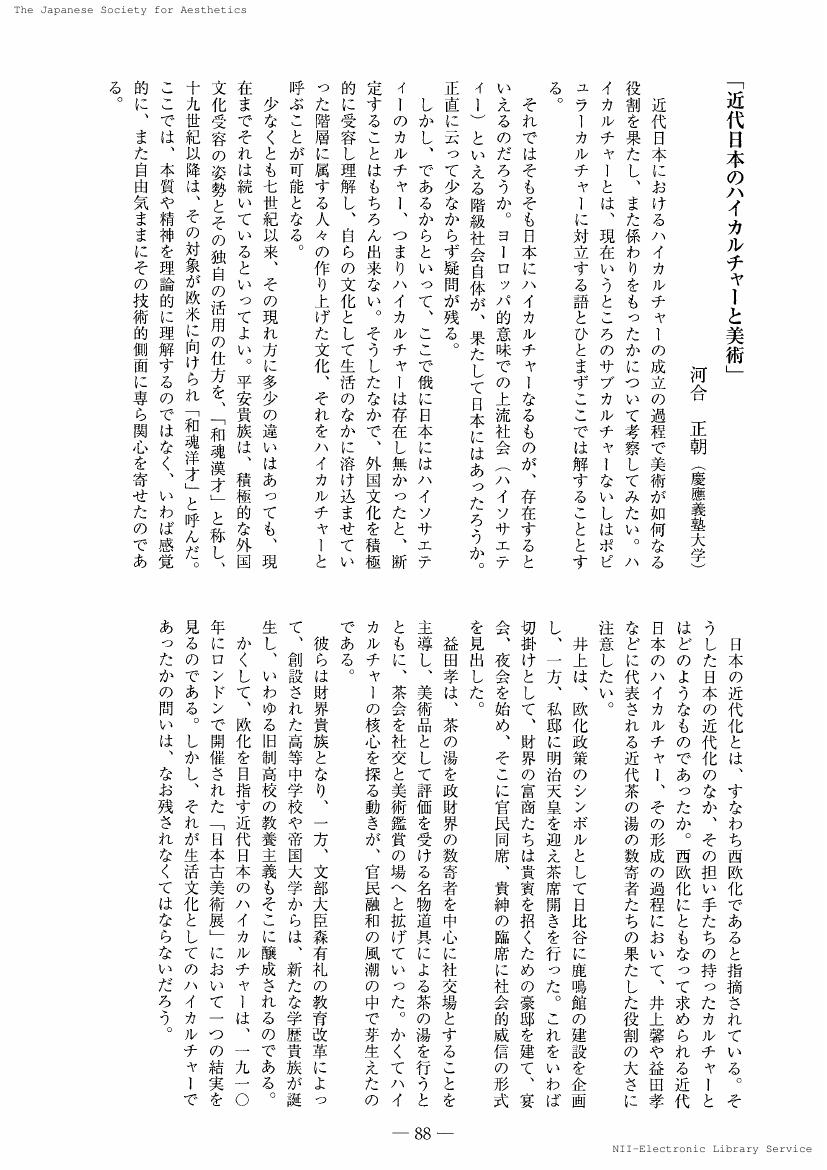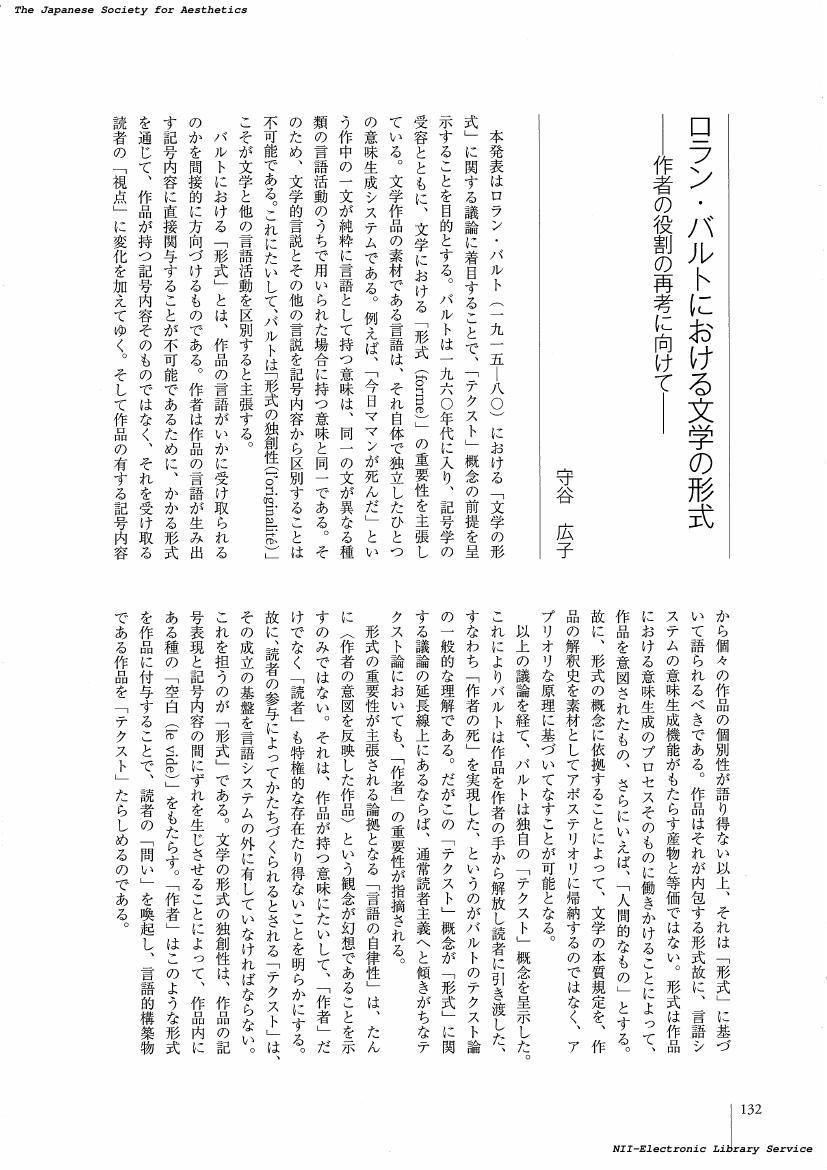2 0 0 0 OA 近代日本のハイカルチャーと美術(東部会平成十八年度第一回例会,例会・研究発表会要旨)
- 著者
- 河合 正朝
- 出版者
- 美学会
- 雑誌
- 美学 (ISSN:05200962)
- 巻号頁・発行日
- vol.57, no.2, pp.88, 2006-09-30 (Released:2017-05-22)
2 0 0 0 OA 世阿弥の「申楽」由来説再検討 その思想的眼目をめぐって
- 著者
- 上野 太祐
- 出版者
- 美学会
- 雑誌
- 美学 (ISSN:05200962)
- 巻号頁・発行日
- vol.69, no.1, pp.147, 2018 (Released:2019-06-01)
2 0 0 0 OA イメージの実在性と半自立性 ジルベール・シモンドン『想像力と発明』をめぐって
- 著者
- 宇佐美 達朗
- 出版者
- 美学会
- 雑誌
- 美学 (ISSN:05200962)
- 巻号頁・発行日
- vol.69, no.2, pp.1, 2018 (Released:2020-03-23)
Rear projection is one of the most frequently used compositing techniques in Hollywood cinema from the 1930s to the late 1960s. Nevertheless, this technique has been hitherto underestimated. Of the scarce existing research, some studies have pointed out the economic advantages of it in terms of the studio system of the day, while others have examined it in the limited context of certain films or film directors. But such approaches have not paid sufficient attention to the fact that the many films had used the technique in spite of harsh criticism regarding the resultant image quality. This paper aims to clarify in part how the images created through rear projection were interpreted by the audiences of the time. The images were surely lacking in terms of the “reality” pursued by classical Hollywood cinema. However, the audiences were able to understand the mechanism of rear projection and experience its effects in a mode separate to that supposed by the classical Hollywood cinema. By analyzing a moving vehicle scene, I demonstrate how the gap created between foreground and background in the images re-arouses wonder in the audience, allowing them to enjoy the medium of cinema as a visceral attraction.
2 0 0 0 OA 「あたらし」/「めづらし」
- 著者
- 土田 耕督
- 出版者
- 美学会
- 雑誌
- 美学 (ISSN:05200962)
- 巻号頁・発行日
- vol.69, no.1, pp.1, 2018 (Released:2019-06-01)
In the beginning of the thirteenth century, during the Shin-kokin period, waka poets followed classicism, reusing words and subjects from old poems. At the same time, they were in pursuit of atarashiki kokoro, or new content. New kokoro does not represent perfect newness that has never been composed; it represents content that overlaps with the classics. Moreover, the word atarashi has ambiguity; while new content is indeed ideal, novel subjects and how to use words are avoided. On the other hand, the word mezurashi means a kind of unexpectedness achieved by using old words in different contexts from past works. Mezurashi becomes especially significant in post-Shin-kokin waka. Nevertheless, since the fifteenth century, old poetry has begun to be ignored, and the focus has shifted to the kokoro of an individual poet. Atarashi, implying a newness that nobody has composed before, is emphasised and involves mezurashi. Such idealisation of novelty, which is regardless of differences from the old, brings the modern meaning of ‘originality’ to medieval waka. However, the classicism of waka never died until the modern era. Autonomous systems that identify differences from the classics as a norm have existed; thereby waka has acquired the extendibility and sustainability of composition.
- 著者
- 松下 哲也
- 出版者
- 美学会
- 雑誌
- 美学 (ISSN:05200962)
- 巻号頁・発行日
- vol.68, no.2, pp.148, 2017 (Released:2019-01-02)
- 著者
- 今井 澄子
- 出版者
- 美学会
- 雑誌
- 美学 (ISSN:05200962)
- 巻号頁・発行日
- vol.68, no.2, pp.128, 2017 (Released:2019-01-02)
2 0 0 0 OA L・B・アルベルティの〈有翼の眼〉と古代エジプト神聖文字
- 著者
- 喜多村 明里
- 出版者
- 美学会
- 雑誌
- 美学 (ISSN:05200962)
- 巻号頁・発行日
- vol.68, no.2, pp.37, 2017 (Released:2019-01-02)
Alberti’s impresa called the Winged Eye, carved in relief in his self-portrait plaque and medals, also drawn on some manuscripts from the end of 1420’s and the 1430’s, was described by Wind (1958) as the divine and awful God’s eye and is like a mystic Egyptian hieroglyph. Alberti was influenced by the discovery of Horapollo’s Hieroglyphica in 1419, and studied about hieroglyphs in the 1420s’ from Fracesco Filelfo, who was translating Pultarch’s Moralia that contains On the Worship of Isis and Osiris. However, it is also interpreted as a human eye since the Winged Eye is linked to the words “QUID TVM” from a poem by Virgil. In Alberti’s text of Anuli, the Winged Eye is a symbol of god and has human qualities such as prudence and providence. The Winged Eye is a Chimera-type image influenced by Egyptian and Greco-Roman cultures and is based on Egyptian hieroglyph’s eye and their amulets, as well as Roman coin reliefs of Octavianus in 38 BC, evil eyes and the Roman Winged Phallus amulets. The author suggests that when Alberti created the Winged Eye, he applied the Greek word “symbollon” which originally means “to throw together.”
2 0 0 0 OA 一九五〇年代の田中一光作品における「日本的なもの」の表現
- 著者
- 山本 佐恵
- 出版者
- 美学会
- 雑誌
- 美学 (ISSN:05200962)
- 巻号頁・発行日
- vol.68, no.1, pp.85-96, 2017 (Released:2018-07-01)
Ikko Tanaka (1930-2002) was a distinguished Japanese graphic designer in postwar Japan. Representations of his design works are diverse. However, the theme of “Japanese tradition” or “Japaneseness” is present consistently in Tanaka’s unique expression in his works. This paper examines the representation of “Japaneseness” of Tanaka’s works in the context of postwar graphic design circles. Tanaka’s design for the “Exhibition of Japanese Textiles at Takashimaya in New York (1959),” which utilized only “kanji (Chinese characters) typography,” has been evaluated by a Western sense of modern design as a work that expressed Japanese traditional culture. Without relying on Japanese motifs such as Mt.Fuji, Japanese cherry, or “geisha”, this is an epoch-making work that expresses “Japaneseness” only through kanji; it is one of the masterpieces in Japanese graphic design history. In this work, Tanaka created “the originality of Japanese Design” by a method of constructing into the design while taking advantage of the function of kanji ideograms. In order to shed the imitation of Western design, Tanaka represented “Japaneseness” by adopting the “zure (gap)” and “kasure (scratchiness)”, which departed from modern design theory, and by devising a new color scheme.
- 著者
- 小倉 健太郎
- 出版者
- 美学会
- 雑誌
- 美学 (ISSN:05200962)
- 巻号頁・発行日
- vol.66, no.2, pp.159, 2015-12-31 (Released:2017-05-22)
- 著者
- 福間 加代子
- 出版者
- 美学会
- 雑誌
- 美学 (ISSN:05200962)
- 巻号頁・発行日
- vol.66, no.2, pp.133, 2015-12-31 (Released:2017-05-22)
- 著者
- 外山 悠
- 出版者
- 美学会
- 雑誌
- 美学 (ISSN:05200962)
- 巻号頁・発行日
- vol.66, no.2, pp.130, 2015-12-31 (Released:2017-05-22)
2 0 0 0 OA 障害と美学 : 身体論的な観点から(第六十六回美学会全国大会発表要旨)
- 著者
- 伊藤 亜紗
- 出版者
- 美学会
- 雑誌
- 美学 (ISSN:05200962)
- 巻号頁・発行日
- vol.66, no.2, pp.116, 2015-12-31 (Released:2017-05-22)
2 0 0 0 OA 幸若舞曲の絵画化と受容空間に関する一考察 : 「曽我物語図屏風」を例として
- 著者
- 井戸 美里
- 出版者
- 美学会
- 雑誌
- 美学 (ISSN:05200962)
- 巻号頁・発行日
- vol.66, no.2, pp.73-84, 2015-12-31 (Released:2017-05-22)
The late sixteenth to early seventeenth century produced many narrative paintings which based on classical literature such as the Tale of Genji and the Tale of Heike. It should be noted however that the number of folding screens which visualized the Tales of the Soga increased, especially in the early seventeenth century. In this paper, I would like to analyze the motifs of the Soga screens that were said to be taken from the Kowaka version of the Tale of the Soga. The motifs which were selected from the text of Kowaka were elaborately juxtaposed on the screen, representing the originality and authority of the warrior families. I will also consider the space of kaisho where warriors gathered for some rituals with a banquet and newly emerging performing arts such as Noh theatre and Kowaka were often performed, since the emergence of the gathering space of kaisho seemed to cause an increase of the production of these narrative folding screens. Kowaka-mai performances, which often narrated stories from war chronicles, functioned not only as a pacificatory requiem for those who had died in past wars but also as an expression of desire for a more peaceful future.
2 0 0 0 OA 西村清和, 『プラスチックの木でなにが悪いのか-環境美学入門』, 勁草書房, 二〇一一年
- 著者
- 秋庭 史典
- 出版者
- 美学会
- 雑誌
- 美学 (ISSN:05200962)
- 巻号頁・発行日
- vol.66, no.1, pp.197-200, 2015-06-30 (Released:2017-05-22)
- 著者
- 守谷 広子
- 出版者
- 美学会
- 雑誌
- 美学 (ISSN:05200962)
- 巻号頁・発行日
- vol.65, no.2, pp.132, 2014-12-31 (Released:2017-05-22)
- 著者
- 桝田 倫広
- 出版者
- 美学会
- 雑誌
- 美学 (ISSN:05200962)
- 巻号頁・発行日
- vol.65, no.1, pp.146, 2014-06-30 (Released:2017-05-22)
- 著者
- 利根川 由奈
- 出版者
- 美学会
- 雑誌
- 美学 (ISSN:05200962)
- 巻号頁・発行日
- vol.64, no.2, pp.132, 2013-12-31 (Released:2017-05-22)
2 0 0 0 OA オディロン・ルドン作版画集《聖アントワーヌの誘惑》 : 類似性と隣接性の一分析
- 著者
- 中村 泰士
- 出版者
- 美学会
- 雑誌
- 美学 (ISSN:05200962)
- 巻号頁・発行日
- vol.64, no.1, pp.119-130, 2013-06-30 (Released:2017-05-22)
Cet article propose d'etudier la methode de visualisation d'Odilon Redon en analysant la tendance de l'association des images dans trois series de La Tentation de Saint Antoine. Redon explique que ses oeuvres sont le fruit <<d'une combinaison de divers elements rapproches, de formes transposees ou transformees>>. Cette citation nous permet d'entrevoir sa methode de combinaison des images par similarite et par contiguite. Aussi, l'analyse des oeuvres d'Odilon Redon par la similarite et la contiguite, que Roman Jakobson presente comme les deux types du developpement d'un discours va-t-elle eclaircir la methode de visualisation symboliste. L'analyse revele, dans la premiere serie, la combinaison par contiguite avec le diable et la combinaison par similarite des dieux paiens et des monstres. On constate egalement dans la deuxieme serie la combinaison par similarite des dieux paiens et des monstres. On peut reconnaitre le caractere dominant de la combinaison par similarite dans les deux oeuvres qui presentent une forte tendance d'association substitutive. A l'inverse, la troisieme serie se caracterise par la superiorite de la description par contiguite et par une forte tendance d'association predicative avec une situation concretisee par l'insertion des paysages. Darts la methode d'Odilon Redon non seulement la substitution par similarite mais aussi la description par contiguite jouent un role important.
2 0 0 0 OA 竹久夢二の生涯における人形製作活動の位置づけ(第六十三回美学会全国大会発表要旨)
- 著者
- 王 文萱
- 出版者
- 美学会
- 雑誌
- 美学 (ISSN:05200962)
- 巻号頁・発行日
- vol.63, no.2, pp.121, 2012-12-31 (Released:2017-05-22)
2 0 0 0 OA 虚構と現実の融解 : アッバス・キアロスタミの『そして人生はつづく』について
- 著者
- 早川 恭只
- 出版者
- 美学会
- 雑誌
- 美学 (ISSN:05200962)
- 巻号頁・発行日
- vol.63, no.2, pp.97-108, 2012-12-31 (Released:2017-05-22)
Many films which take disasters like earthquakes as their subjects are fictional. And life goes on (1992) is a movie about the big 1990 earthquake in Iran. However, fiction and reality are interwoven equivalently by Kiarostami. This truly reflects his own style of making films. The earthquake really hit a place where Kiarostami had shot a previous film, and And life goes on is just a fiction based on reality, in which a cineaste who is an actor travels with his son to ask the safety of previous cast members. This film can pretend to be a documentary, but includes the exposure of being fiction, and its fictional images are contrasted by the views of the devastated area and victims' narration. However, the local children seem to play what they should be beyond themselves and their roles in the film. In such their self-direction, we can recognize a truth about children who have got not only a victims' desire to continue living and their daily lives but also the film makers' desire to expect such a situation. The evidence of a child's life can be brought to such interstice between fiction and reality, where the difference between them melts and fuses.












